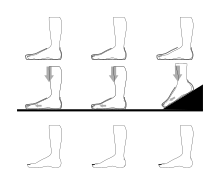Subungual hematoma
| Subungual hematoma | |
|---|---|
| Other names | Runner's toe, tennis toe, skier's toe |
| Treatment | Usually unmerited, blood drainage or nail removal in serious cases |
| Prognosis | Usually self-resolving as nail grows out |

A subungual hematoma is a collection of blood (hematoma) underneath a toenail or fingernail. It can be extremely painful for an injury of its size, although otherwise it is not a serious medical condition.
Nature
A laceration of the nail bed causes bleeding into the constricted area underneath the hard nail plate.[1] The blood pools under the nail, giving a reddish, brownish, blueish, or grey/blackish discoloration. The blood puts pressure to the nailbed causing pain which can be throbbing in quality and disappears when the pressure on the nail bed is relieved.[2]
Subungual hematomas typically heal without incident, though
The nail plate may also become thicker and more brittle as a result of the injury (onychochauxis). The deformed nail plate will gradually grow out and be replaced by new, normal-appearing nail plate in several months' time. Infrequently, the nail may become painful and require surgical drainage.[5]
Causes


The condition is caused by a
Repeatedly thrusting the toes against a shoe's toe box can cause a subungual hematoma called jogger's toe,[8] runner's toe, or black toenail. In a marathon, several percent of runners may be affected.[4] Wearing footwear which fits helps prevent runner's toe.[4]
If the shoe is too loose on the midfoot, the foot can slide forwards in the shoe, especially when going downhill. This may jam the toes into the end of the toebox.
Separately, if there is not enough space around the toes, the toes will also hit the toebox repeatedly.[4] Feet become longer and wider when weight is put on them, because the arches flatten, and the toes also splay and bend.[7]: p15, 18, 72–73 At the end of a long journey on foot, the arches flatten, the metatarsals spread, and the foot swells more than after a short one.[7]: 52 The toes also need vertical space; a toe cap which is low enough to press on the top of the toe may also cause bruising under the nail, especially if the toe cap is stiff. If the toebox is pointed, the toes may be wedged forwards into the area with inadequate height.[7]: 52–53, 135
Toenails which protrude unevenly may concentrate force on the toenail;
Some susceptible runners may also have
Treatment
Subungual hematomas can resolve on their own, without treatment being necessary.[4] If they are acutely painful,[9] they may be drained.[5]
Subungual hematomas are treated by either making a hole through the nail into the hematoma (
In a hospital or medical setting, trephining is generally accomplished by using an
Removal of the nail is typically done when the nail itself is disrupted, a large laceration requiring
Complication rates from both forms of treatment are low, and the nail generally recovers to a normal appearance.[9]
-
Thumb before drainage.
-
After drainage; note draimage hole.
See also
- List of cutaneous conditions
- Turf toe
References
- ISBN 978-0-7817-5074-5.
- PMID 29494114.
- ^ a b "3 Tips to Protect Your Toenails If You're a Hard-Core Runner". Health Essentials from Cleveland Clinic. 3 December 2015.
- ^ PMID 15273194.
- ^ PMID 29494114.
- ^ "Subungual Hematoma: Care Instructions". myhealth.alberta.ca.
- ^ a b c d e f Munson, Edward Lyman (1912). The soldier's foot and the military shoe; a handbook for officers and noncommissioned officers of the line. Menasha, Wis.: Press of the George Banta publishing company. (this is the publication of a four-year review into the footwear of the US military by the Army Shoe Board, of which the author, a physician and senior officer of the United States Army Medical Corps, is president.
- PMID 15273194.
- ^ PMID 22351556.
- ^ "Primary Care Procedures: Trephination of Subungual Hematoma". consultantlive. UBM Medica, LLC. Archived from the original on 21 August 2016. Retrieved 30 July 2016.


